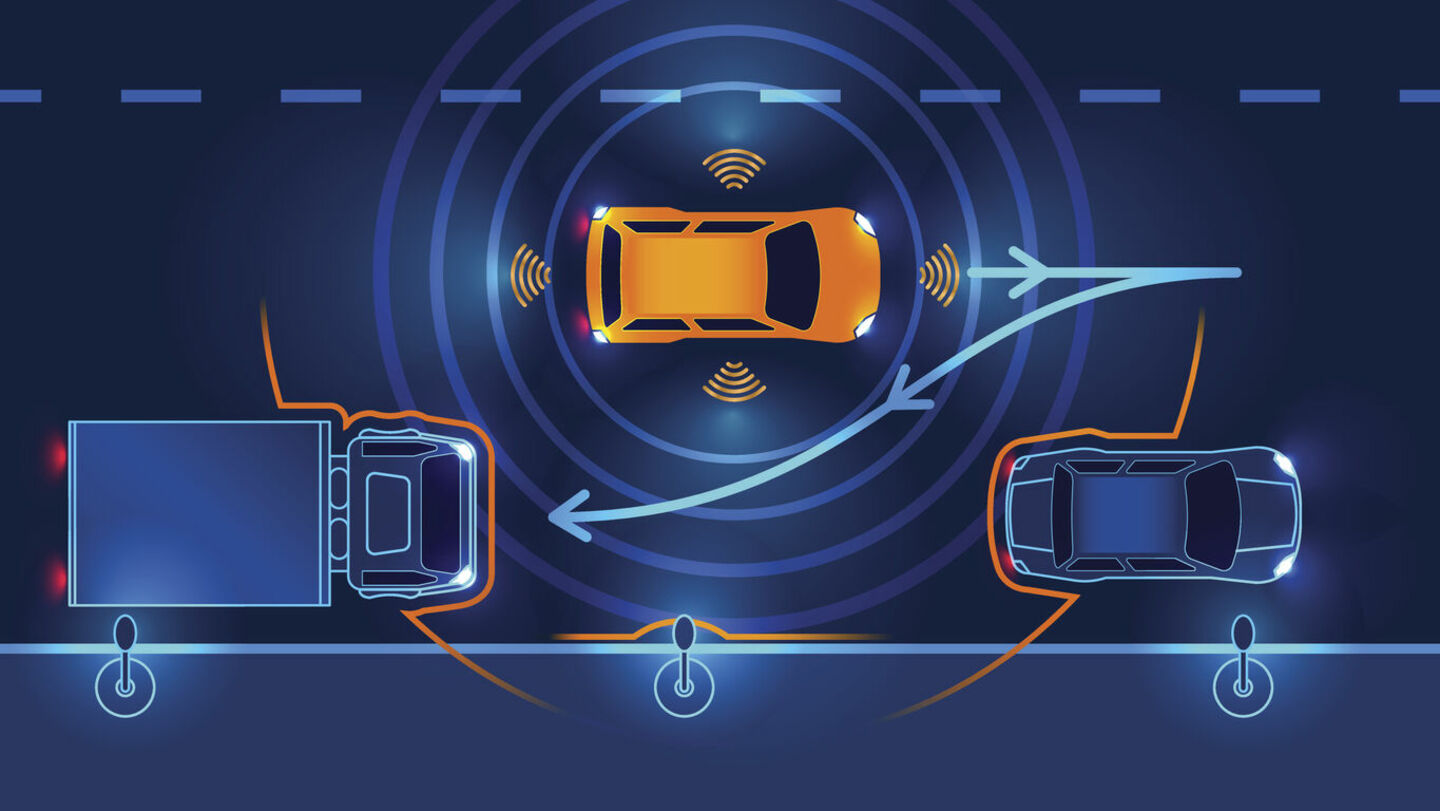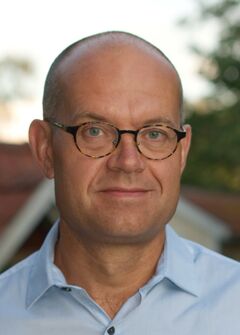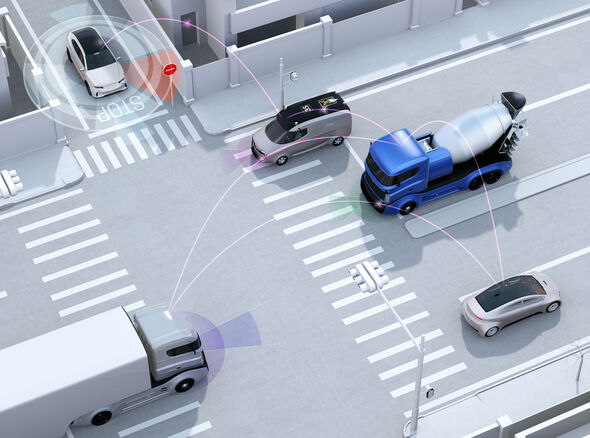
6G will accelerate autonomous driving
6G comes to us in the near future: what does it mean for the industry and what are the benefits for the individual?
It is estimated that we will be able to use 6G in 2030. By then, it will be technically possible for cars to drive autonomously and communicate with each other, but whether society is ready to accept that is something else. Researchers from TU/e, NXP and Ericsson talk about where the technology stands at the moment and what is important in the further development of our communication network.
People want to be connected anywhere, anytime these days. In the future, wireless communication will even be one of the most important topics, according to associate professor and director of the Center of Wireless Technology (CWTe) Ulf Johannsen.
“My wife is from England and I regularly travel on the ferry. There is no connection there. The same goes for air travel, although it is starting to come there, but it is still very expensive. When we roll out 6G, we want to offer more satellite connections.”
Johan Lundsjö, Strategic Research Communications Director has a clear vision for the future of 6G in society. “It will be interesting for both business and consumers. I’m expecting the first commercial systems in 2030. That will still be on a small scale. In 2035, 6G will be widely deployed and used.” That’s ten years from now, but time flies and so does technology.
“By then, there will be macro trends like electrification in society, renewable energy, electrical engines, many more electric cars, automation in society, robotics applied in both industry as well as for consumers, traffic systems with connected vehicles”, the communications director forecasts. “Of course some of those things already exist today or are of importance already, but by then it will be on a much broader scale. Take the traffic network; that needs very a network that is very reliable, resilient and secure. With the ongoing digitalization, society needs mobile systems to connect everything. 6G offers that to society.“
Major collabs
The projects around 6G are broad. For example, there is a major growth fund project: Future Network Services (FNS). It now has sixty partners, including TU/e. “And we have always collaborated a lot with Ericsson in Sweden,” Johannsen says. “Then there is also the Etain project, a major European project that focuses on planetary health.”
Marcel Geurts is senior program manager at NXP and a member of the management team of the FNS growth fund project. Geurts: “In terms of collaboration with TU/e, we have mainly worked a lot with Bart Smolders' group. In addition to the FNS consortium, we have also worked on 5G and in Marie Curie programs such as Silika and MyWave. And some of my NXP colleagues are part-time professors at TU/e and we supervise PhD candidates.”
Ulf Gustavsson, Technology Specialist at Ericsson, has also done a lot of collaboration with TU/e. “I focus on radio signal processing and have been working with the university for over ten years, including on the Silika project and the Anterra project. And of course, we are also part of the FNS group.”
Importance of early collaboration
Rob Hoeben is senior director of strategy at NXP and is also on the Supervisory Board of FNS together with TU/e rector Silvia Lenaerts, among others. Hoeben: “We collaborate with more universities and research institutions, but I can say that our collaboration with TU/e is the closest and most extensive.”
The government, research institutions and industry have been working together for many years before the launch of 6G. Why do they believe it’s necessary? Many different partners are involved in the development of 6G and TU/e’s CWTe tries to coordinate this collaboration. Johannsen: “For example, you have KPN as a provider and NXP as the chip developer, making the right chips for the technology. But they have to be in production on time to deliver on time. That is why early collaboration is important.”
“We have a lot of knowledge of technology and how it’s developing,” says Hoeben of chipmaker NXP. “It is good that we can influence the technical standard, because we will have to design matching chips later. We learn not only from academics about the technology, but also from providers about what the consumer needs are. We can then translate that into what requirements the chips need.”
“The society has changed over the years,” notes NXP colleague Geurts. “In the past, the provider made something for the mobile phone and people accepted it: from 3G to 4G and 5G. That is no longer the case. Now, more attention is paid to what is really needed in society, which is now broader than an application for the radio or mobile phone.”
Difference with 5G
“Roughly speaking, 5G was more focused on the industry and 6G more on the consumer,” Johannsen knows. “That’s not entirely true, but to simplify it a bit. What was new with 5G was ‘massive MIMO’. A 4G antenna radiates in every direction, everyone receives the signal from that antenna. With 5G, bundles are created from multiple antennas that can be specifically aimed at one person. This allows you to use the same frequency for multiple people. That was not possible before.”
“So the network is already being used more efficiently. We are now trying to improve that even further. The focus is now on higher frequencies, where the bundles can be made even smaller.”
We go from 5G to 5.1G, 5.2G, etc. up to 6G. There is about ten years between them. Every ten years such a new network contains a major adjustment
Increasingly higher frequency
Transitioning to 6G involves the implementation of a new telecom standard, which goes from a low to an increasingly higher frequency. The use of sub-terahertz is also being considered. But what’s the use of all those bandwidths possible? "There are use cases for that, but the efficiency and effectiveness still have to be proven in practice," Hoeben knows. "An example of this is the application of 6G in traffic, autonomous driving."
Incidentally, it is not the case that there is 5G and then immediately 6G after a few years. That happens in steps. Johannsen: "We go from 5G to 5.1G, 5.2G, etc. up to 6G. There is about ten years between them. Every ten years such a new network contains a major adjustment."
"The costs always precede the benefits," NXP director Hoeben knows from experience. "After all, you are innovating for years first. That is why the subsidies from the Dutch government and Europe are so important."
Future applications
There are various applications for 6G, but the most frequently mentioned option is autonomous driving. And then you should not only think of driving without having to steer or brake yourself, but also mutual communication between all vehicles and acting accordingly, and even automatic highly efficient route planning.
Johannsen dares to dream about the future. “I can imagine that you no longer have a car, but an app. Maybe still on your phone, maybe you don't even need that device anymore.”
“You tell your app that you want to go to Eindhoven today and want to arrive there at 4 PM. Then the app will search for people who also want to travel that route and time and will search for an available car. The algorithm knows where everyone wants to go and thus makes the most efficient planning. This not only solves traffic jams, we also have to produce and park far fewer cars. And it is cheaper, because you no longer have to pay for your car in full.”
With this technology cars can look around corners. That helps to make them drive in the most efficient way
When asked to dream a bit about 6G’s possible applications, Lundsjö also calls out the autonomous traffic system like Johannsen. “And let me add that we this technology it will become possible for the cars to look around corners, a car today with current sensors and cameras can’t, but if they get connected, they will be able to. AI will also be of great use in this sector to make cars and buses act in the most efficient way.
And when 6G is launched in 2030, work will not be finished yet, the gentlemen from Ericsson are convinced. “A lot of research is still needed to improve the technology. Especially with regard to antenna technology and its efficiency. And climate change can also change the way we have to deal with this technology in the (near) future.”
More on autonomous driving
“If you really want to drive autonomously, it would also be useful if those cars could talk to each other via wireless communication,” says Johannsen. “For that, you need joint sensing and communication. You use the car radar not only to detect but also to communicate. Normally, if you give an additional task, the output of both gets worse because there is a certain maximum power that you can transmit. If there are two functions, you have to divide that power.”
You often hear people are afraid of autonomous driving, is that justified? “We are not suddenly going from driving ourselves to cars driving autonomously,” Johannsen says. “That too happens in small steps. For example, with more autonomous options, which you can switch on or off yourself while you still have to pay attention, such as cruise control. We are also used to that.” At some point, we will move towards a car in which you can quietly read a book, Johannsen thinks. “But that will take a while.”
We also grant machines fewer mistakes than people and are more critical when things go wrong. “If cars can communicate with each other, they will see a traffic jam in time and at the same time they can anticipate those better than people.”
But systems can actually do things that we cannot do (as well). “Someone has had a heart attack and the communication system detects that and immediately calls an ambulance. That is nice for the victim, but also offers options for people on the road who can see what is going on - live via Google Maps - and can make a different choice for their route to avoid traffic jams. Of course we have to see whether this is allowed with the privacy rules in Europe, but as you can’t recognize people on a radar image I don’t think it’s a bad idea.”
Digital twins
Besides the big change towards autonomous traffic, digital twins will be another useful application of 6G, the Ericsson director thinks. “It can be a digital twin of a car or complete transportation system, but also something completely different. A digital twin allows you to play with AI and test and try what ideas would do in the real world. The results can be used in the real world later on. 6G will keep the digital world and the physical world in sync.”
Smart glasses
Lundsjö also believes the future holds special glasses. “I know Apple and also competitors like Google have announced them already multiple times in the past, but I really believe augmented reality and virtual reality will come to a new level. Especially design-wise; there will be options to have them look exactly like your favorite Rayban.”
“And the technology will allow me to do everything I do with my smartphone now with my glasses. In fact I won’t even need my smartphone anymore. The challenge now is how to design the glasses so they don’t become to heavy or hot.” And then he doesn’t mean sexy. “There needs to be a processor and a battery. The computing of data generates heath. We need to see to the most optimal conditions.”
Gustavsson adds to his colleague: “And if in the future many people will use this, similar to current’s smartphone usage, it will ask a lot from our network. That’s also something we work on, keeping the connections stable with this higher demand.”
Radiation being criticized
When 5G was first discussed, there was already quite a bit of resistance from certain parts of society. People were and are afraid that radiation will negatively affect their health. Is that taken into account when developing 6G? “The tricky thing is that not everyone wants the same thing,” says Johannsen. “Some people or companies want high speed connections, so you also need a strong signal. Others don’t want a signal at all.”
“A PhD candidate is now doing research into this in the ETAIN project: how do we optimally align the antennas towards the users and at the same time minimize the signal strength for people who don’t want a signal. Furthermore, I don’t dare to explain the impact of radiation because that is not my field of expertise.”
Regarding criticism of radiation, Hoeben and Geurts from NXP indicate that this is not their area of expertise either. “The government determines the framework of what is safe and we make components that comply with the law. Within FNS, we also have an ethics expert who is more involved in this area.”
More base stations and satellite connections
Johannsen points to the Gemini building. “You see a mast there, just like besides many highways. But you don’t have those in the air or at sea. Satellite connectivity, on the other hand, is an option anywhere.”
“Satellite use already exists in 5G networks,” Gustavsson knows. “But for all these ambitious plans, it’s not enough. So we look at small base stations every couple of meters. Wherever you go in a city there would be a base station in every five to six meters. Lots of data will go back and forth. In rural areas you need less, maybe every few 100 meters or even a kilometer in between them.”
Lundsjö adds that this doesn’t mean that the whole current data infrastructure will be replaced. “We will just add stations in some areas. And we will focus on satellite networks to better connect people on sea, in the air and on very rural areas. The future consists of 3D coverage to connect all the different places, people and types of usage.”
Gustavsson nods. “If we put base stations on satellites, they move at high speed, so we need 6G to connect those. And think of drone swarms, they also move a lot and can be used for many different applications, but need a very strong network to be successful.”
Sustainability
A lot of data usage is not per se sustainable. Johannsen is very aware of this. “ICT infrastructure uses a lot of energy, an important point. People often think that they are being sustainable by travelling less to work, but the video calling that comes instead also has an impact on the environment. That is why we are also looking at how we can make 6G more energy-efficient than 5G. Then we will soon have faster internet with more options but with less energy consumption. Furthermore, our autonomy as a country is also important: we need to make more things in Europe to be less dependent on geopolitical fluctuations.”
Lundsjö says there is more attention for sustainability in the development of technology these days. “In the case of 6G it’s very important to look at its energy usage for example. But also geopolitics and natural disasters have influenced the development. We need to have a network secure on all levels. 4G and 5G are also very strong already, but there are always new threats coming. But this topic is a research area on its own.”
“We design the 6G system so that the system itself does not consume too much energy,” says Lundsjö. “The goal is that the system can reduce energy consumption as a whole in society. If 6G reduces more energy consumption than it uses itself, then we will have a real profit. That is what we are committed to.”
Attracting talent
Hoeben is pleased with the collaborations between the government, academia and the industry. “I think it is important that we keep doing that, because that is what makes our ecosystem so strong here. We can be proud of our semiconductor and electrical engineering ecosystem, which is broader than ASML, of course still the largest player in the Netherlands.” But there is work to be done to keep the ecosystem the way it is now, the gentlemen acknowledge.
“The system requires maintenance in several ways, the success of which is mainly based on talent attraction,” Hoeben knows. “In the selection process, it is not only important that someone had good grades for physics and that their semiconductor knowledge is in order. Cooperative characteristics are particularly important because there is so much collaboration going on here.”
His colleague Geurts agrees: “Those characteristics are less easy to extract from a list of grades. We manage to find and bring smart people here, but getting them to work well together is still a challenge. We have 33,000 people working for us. That requires a lot of organization and matching.”
Hoeben: “But more Dutch talent – both in terms of figures and collaboration skills – is needed. How do we get more people to study science here? Especially women? In Southern Europe, many more women are engineers than in the Netherlands. Women are certainly not less intelligent here.” Geurts: “It seems to be culturally bound. In countries where more women choose science studies, you also see that this is strongly encouraged much earlier, already in primary school. So that path also has to be stimulated much earlier and more intensive here in the Netherlands.”







Discussion